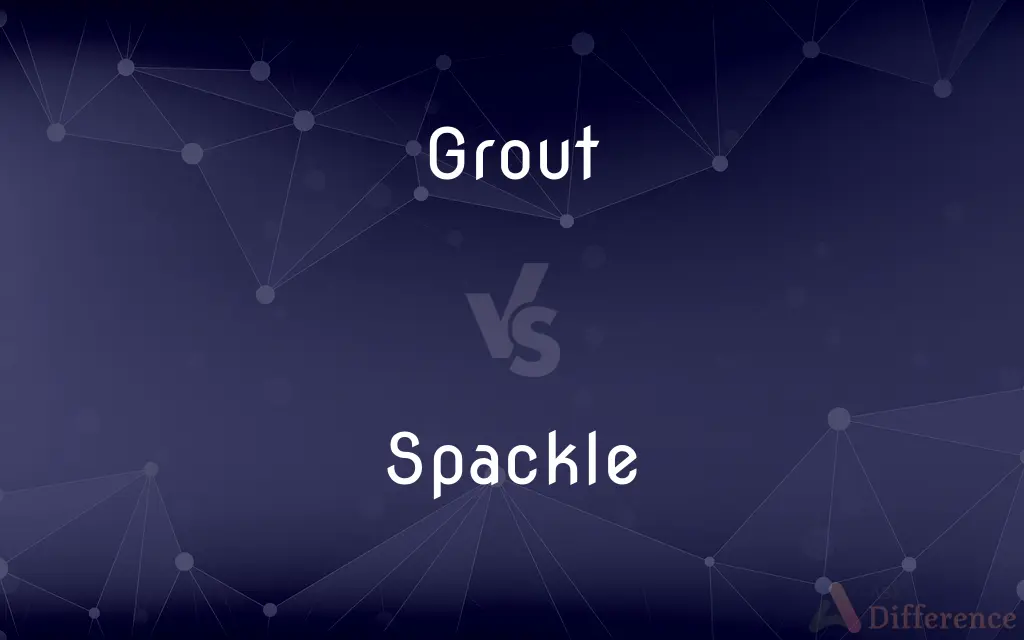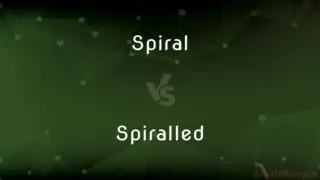Grout vs. Spackle — What's the Difference?
By Tayyaba Rehman & Maham Liaqat — Updated on March 8, 2024
Grout fills tile gaps, hardening for durability, while Spackle repairs walls, easy to sand and paint.

Difference Between Grout and Spackle
Table of Contents
ADVERTISEMENT
Key Differences
Grout is a mixture used to fill spaces or joints between tiles, providing a finished look while also adding strength and protection against moisture. It is typically composed of water, cement, and sand, which hardens over time to form a durable seal. On the other hand, Spackle is a putty-like substance used for repairing small holes, cracks, and imperfections in walls and ceilings. It is designed to be easy to apply and sand, making it ideal for preparing surfaces for painting.
Grout's primary use in tiling means it needs to resist water and staining, making it available in sanded and unsanded varieties to suit different joint widths and aesthetic preferences. It requires mixing before application and careful cleaning to avoid haze on tiles. Spackle, in contrast, comes ready to use, with lightweight and fast-drying formulations that simplify wall repairs. Its ease of sanding allows for a smooth finish that can be painted or wallpapered over.
While grout must match or complement tile color, offering aesthetic cohesion and water resistance in wet areas, Spackle is usually white but can be painted over to match the surrounding surface. This color adaptability makes Spackle versatile for interior finishing and repairs.
The application process for grout involves spreading it across tile surfaces and pressing it into joints, followed by curing and sealing to maintain durability and appearance. Spackle application is simpler, involving filling holes or cracks, smoothing, and then allowing it to dry before sanding to achieve a seamless surface.
Durability is a key difference: grout is designed for long-term resistance to water, pressure, and wear in tiled areas. Spackle, while durable after painting, is more for cosmetic repairs and may need reapplication over time, especially in high-traffic areas or if underlying issues cause further damage.
ADVERTISEMENT
Comparison Chart
Composition
Water, cement, sand
Gypsum, binders, and possibly other fillers
Primary Use
Filling tile joints
Repairing wall imperfections
Application
Mixed before use, applied with a float
Ready to use, applied with a putty knife
Finish
Needs sealing, color variety
Easy to sand, paintable
Durability
Resistant to water and pressure
Suitable for cosmetic repairs
Compare with Definitions
Grout
Filling tile joints.
Grout is used to fill the spaces between tiles, ensuring a finished look.
Spackle
Wall repairs.
Spackle is ideal for filling small holes and cracks in walls.
Grout
Needs sealing.
After grout cures, it should be sealed to protect against moisture and stains.
Spackle
Paintable.
Spackle accepts paint well, allowing for seamless color matching.
Grout
Durability.
Once cured, grout provides a durable surface that withstands regular use.
Spackle
Lightweight.
Lightweight Spackle is perfect for quick fixes without sagging.
Grout
Moisture resistance.
Properly sealed grout prevents water from seeping between tiles.
Spackle
Easy to sand.
After drying, Spackle can be sanded smooth to create an invisible repair.
Grout
Color options.
Grout comes in various colors to complement or contrast tile designs.
Spackle
Ready to use.
Spackle comes in a ready-to-use formula, simplifying small repair jobs.
Grout
(archaic) Coarse meal; groats.
Spackle
Any powder (originally containing gypsum plaster and glue) that when mixed with water forms a plastic paste, which is used to fill cracks and holes in plaster.
Grout
Grout is a dense fluid which is used to fill gaps or used as reinforcement in existing structures. Grout is generally a mixture of water, cement, and sand and is employed in pressure grouting, embedding rebar in masonry walls, connecting sections of pre-cast concrete, filling voids, and sealing joints such as those between tiles.
Spackle
A plastic paste meant for filling cracks and holes in plaster.
Grout
A thin mortar used to fill cracks and crevices in masonry.
Spackle
A paste-like substance that fills a gap.
Grout
A thin plaster for finishing walls and ceilings.
Spackle
(transitive) To fill or repair with a plastic paste.
Grout
Often grouts Chiefly British Sediment; lees.
Spackle
(intransitive) To fill cracks or holes with a spackle.
Grout
To fill or finish with a thin mortar or plaster.
Spackle
To fill gaps with something, as if spackling; to speckle
The neighborhood has been spackled with coffee shops.
Grout
A thin mortar used to fill the gaps between tiles and cavities in masonry.
Spackle
Powder (containing gypsum plaster and glue) that when mixed with water forms a plastic paste used to fill cracks and holes in plaster
Grout
Dregs, sediment.
Grout
A kind of beer or ale.
Grout
To insert mortar between tiles.
I spent the whole afternoon grouting the kitchen floor.
Grout
To affix with mortar.
Grout
Coarse meal; ground malt;
Grout
Formerly, a kind of beer or ale.
Grout
Lees; dregs; grounds.
Grout
A thin, coarse mortar, used for pouring into the joints of masonry and brickwork; also, a finer material, used in finishing the best ceilings.
Grout
To fill up or finish with grout, as the joints between stones.
Grout
A thin mortar that can be poured and used to fill cracks in masonry or brickwork
Grout
Bind with grout;
Grout the bathtub
Common Curiosities
Can Spackle be used to fill tile joints?
No, Spackle is not suitable for tile joints as it lacks the durability and moisture resistance of grout.
How long does Spackle take to dry?
Drying times vary, but lightweight Spackle can dry in as little as a few hours.
Can grout color be changed?
Yes, grout color can be changed using a grout colorant or by re-grouting.
What is grout made of?
Grout is primarily composed of water, cement, and sand.
Is Spackle easy to sand?
Yes, Spackle is designed to be easy to sand for a smooth finish.
Is grout waterproof?
Grout itself is not waterproof but can be sealed to protect against water.
Can Spackle be used on wood?
Yes, but it's primarily designed for plaster or drywall repairs.
Do I need to seal grout?
Yes, sealing grout is recommended to protect it from moisture and stains.
Can I use Spackle outside?
Spackle is generally for interior use; exterior repairs require more durable materials.
What's the difference between lightweight and all-purpose Spackle?
Lightweight Spackle is easier to sand and ideal for small repairs, while all-purpose Spackle is denser and suitable for larger fixes.
Why does grout crack?
Grout may crack due to movement, improper installation, or moisture issues.
Is there a quick-drying grout for fast repairs?
Yes, some grout formulas are designed for quick setting, suitable for fast repairs.
How often should grout be replaced?
It depends on wear and damage, but grout can last many years with proper care.
How do I choose the right type of grout?
Consider the tile spacing and location; sanded for wider joints and unsanded for narrower or delicate tiles.
Can I paint over Spackle without priming?
It's best to prime Spackle before painting for the best finish and adhesion.
Share Your Discovery

Previous Comparison
Spiral vs. Spiralled
Next Comparison
Thrill vs. HeavesAuthor Spotlight
Written by
Tayyaba RehmanTayyaba Rehman is a distinguished writer, currently serving as a primary contributor to askdifference.com. As a researcher in semantics and etymology, Tayyaba's passion for the complexity of languages and their distinctions has found a perfect home on the platform. Tayyaba delves into the intricacies of language, distinguishing between commonly confused words and phrases, thereby providing clarity for readers worldwide.
Co-written by
Maham Liaqat













































